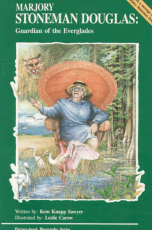This morning, on International Women's Day, I am thinking of the several remarkable women about whom I have written: Lucretia Mott, Anne Frank, Abigail Adams, Eleanor Roosevelt, Harriet Tubman, and another—Marjory Stoneman Douglas, who until recently was less of a household name. The February 14 massacre that killed seventeen students and staff changed all that. Since then, students from Marjory Stoneman Douglas High School in Parkland, Florida, have met with lawmakers in Tallahassee and turned to social media to advocate for gun control. They've discussed the effects of gun violence with students from Chicago. They've successfully pushed for companies to withdraw their support of the National Rifle Association. As a result, the First National Bank of Omaha, Avis and Enterprise, United and Delta, and MetLife are no longer offering discounts to NRA members.
These high school activists are as feisty and passionate and caring as Marjory Stoneman Douglas once was.
This crusader who would go on to become an ardent environmentalist and guardian of the Florida Everglades, was born in MInneapolis in 1890 and spent her childhood in Taunton, Massachusetts. From the time she was little she wanted to become a writer. At Welleslesy College, her professor criticized her "too free" writing style; still her work was published in the college literary magazine and she went on to write short stories that were published in the Saturday Evening Post. She campaigned for women's suffrage and later moved to Miami where she became a columnist for the Miami Herald. In writing about the threat to the Everglades—the irreparable damage that would come from drainage and cultivation—she found the cause that would become her life's work. Her book "River of Grass," published in 1947, championed the great beauty of the Everglades—the live oak, the cypress, and the mangrove, the egrets, the wood stork, herons, and spoonbills—and it brought to light the delicate balance and web of life. It was destined to become a classic and a rallying cry for environmentalists across the country.
Marjory lived to be 108. When I first met her at age 104, she was still going strong. She was an inspiration for all of us and passed bits of wisdom, including the following six steps for environmental activists to follow:
1. Know your region
2. Involve neighbors and friends
3. Join a local environmental society
4. Do what you would do best to help your group
5. Speak up. Learn to talk clearly and forcefully in public
6. Be discouraged and disappointed at failures and the effects of ignorance, greed, and bad politics—but never give up.
The high school students from Parkland have already taken her advice to heart—not to save the Everglades, but to stop gun violence.
